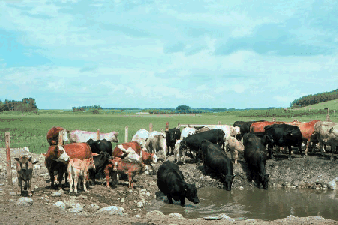| | What is veterinary surveillance | Why is veterinary surveillance important | Veterinary surveillance and human health | Veterinary surveillance in Alberta | Links

What is Veterinary Surveillance?
Veterinary surveillance refers to the ongoing and timely collection, analysis and monitoring of information related to poultry and animal health, and dissemination of that information to veterinarians, producers and government agencies to help them make informed decisions for poultry and animal health management.
Why is Veterinary Surveillance Important?
Veterinary surveillance is essential for the early detection of unusual, infectious, rare or emerging disease events, or changes in existing disease patterns. It also facilitates the timely and effective communication of information to veterinarians, producers and government agencies to assist in decisions about health issues in Alberta's poultry and livestock. Surveillance is important because it:
- Allows for early detection of disease
- Assists in the development of effective control and recovery programs
- Supports market access
- Is a crucial part of Alberta's Argi-food industry
Veterinary Surveillance and Human Health
Zoonoses are diseases that are communicable from animals to humans. Data from both veterinary and human surveillance systems provides the information needed by researchers to fully understand these diseases. In recent years Canada has experienced zoonotic disease outbreaks related to:
While human health and food safety are top priority, global outbreaks of diseases like BSE ("mad cow disease"), avian influenza and foot-and-mouth disease have made governments, veterinary professionals and producers acutely aware of the economic importance of animal disease surveillance to maintain market access, nationally and internationally.
Many experts think that worldwide increases in international travel and trade have elevated the risk of foreign animal disease (FAD) outbreaks1. FAD's are diseases not normally present in Canada, examples of a few FAD's are: foot-and-mouth disease and classical swine fever. Early detection of these outbreaks is important to minimise their spread and impact – which is why we must have an effective veterinary surveillance system .
The Government of Alberta responded by developing the Alberta Veterinary Surveillance Network.
to support producers, private veterinarians and a team of animal health disease experts to address poultry and livestock disease issues that affect industry, food safety and human health.
Veterinary Surveillance in Alberta

Alberta Agriculture and Rural Development (ARD) conducts veterinary surveillance through:

References

| 
|

1. | 
FAO. Without Effective Veterinary Services Animal Diseases could Spread Globally. Food and Agriculture Organization of the United Nations. 2000. Food and Agriculture Organization of the United Nations. Ref Type: Report |
Useful Links
Food Safety and Animal Health Division
Office of the Chief Provincial Veterinarian (OCPV)
Alberta Veterinary Medical Association (AB.VMA)
World Organization for Animal Health (OIE)
Food and Agriculture Organization of the United Nations
Canadian Food Inspection Agency |
|